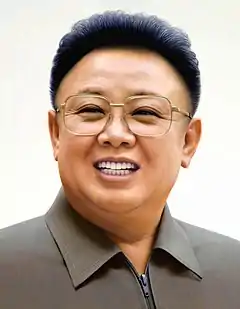Kimjongilia
Kimjongilia is a flower named after the late North Korean leader Kim Jong-il. It is a hybrid cultivar of tuberous begonia, registered as Begonia × tuberhybrida 'Kimjongilhwa'.[1] When Kim Jong-il died in December 2011, the flower was used to adorn his body for public display.[2] Despite its name, the Kimjongilia is not the official national flower of North Korea,[3] which is the Magnolia sieboldii.[4] Another flower, Kimilsungia, is an orchid cultivar named after Kim Jong-il's father and predecessor, Kim Il-sung.[3]
| Begonia 'Kimjongilhwa' | |
|---|---|
.jpg.webp) | |
| Genus | Begonia |
| Cultivar group | Tuberhybrida Group |
| Cultivar | 'Kimjongilhwa' |
| Kimjongilia | |
| Chosŏn'gŭl | |
|---|---|
| Hancha | |
| Revised Romanization | Gimjeongilhwa |
| McCune–Reischauer | Kimjŏngirhwa |
History
To commemorate Kim Jong-il's 46th birthday in 1988, Japanese botanist Kamo Mototeru cultivated a new perennial begonia named "kimjongilia" (literally, "flower of Kim Jong-il"), representing the Juche revolutionary cause of the Dear Leader.[5] It was presented as a "token of friendship between Korea and Japan".[6] The flower symbolizes wisdom, love, justice and peace. It is designed to bloom every year on Kim Jong-il's birthday, February 16.[7]
Bloom
The flower has been cultivated to bloom around the Day of the Shining Star, Kim Jong-il's birthday, 16 February.[8] According to the Korean Central News Agency, a preservation agent had been developed that would allow the flower to keep in bloom for longer periods of time.[9]
Song
A song composed by several North Korean composers, also called "Kimjongilia", was written about the flower:[10]
The red flowers that are blossoming over our land
Are like hearts: full of love for the leader
Our hearts follow the young buds of Kimjongilia
Oh! The flower of our loyalty!
See also
References
- "ABS Registered Begonias (G - O)". American Begonia Society. Retrieved 27 February 2015.
- "Succession in North Korea: Grief and fear", The Economist, December 31, 2011.
- Minahan, James (2010). The Complete Guide to National Symbols and Emblems. 1. Santa Barbara: ABC-CLIO. p. 82. ISBN 978-0-313-34497-8.
- Lim, Reuben C. J. (29 June 2013). "Floral Emblems of the world". anbg.gov.au. Australian National Herbarium. Retrieved 9 September 2016.
- Chong, Bong-uk (1998). A Handbook on North Korea. Naewoe Press. p. 101.
- Lankov, Andrey Nikolaevich (2007). North of the DMZ: Essays on Daily Life in North Korea. McFarland. p. 21. ISBN 978-0-7864-2839-7. OCLC 1023223619.
- Ford, Glyn; Kwon, Soyoung (2008). North Korea on the brink: struggle for survival. Pluto Press. p. 98. ISBN 978-0-7453-2598-9.
- Birthday of Kim Jong-Il. Holidays, Festivals, and Celebrations of the World Dictionary (Fourth ed.). Omnigraphics. 2010. Retrieved 13 January 2017 – via TheFreeDictionary.com.
- "Agent for Preserving Kimjongilia Developed", KCNA, October 21, 2008.
- Lanʹkov, 2007, p. 22.
Further reading
- Choe Song Hak; Kim In Il, eds. (2007). Kimjongilia (PDF). Plant in Full Bloom. 1. Translated by Kim Kun Hui. National Institute for Standardization. OCLC 837310890.
- Pak Ryong Ung; et al. (2011). Thak Song Il; et al. (eds.). Encyclopedia of Kimjongilia (PDF). Translated by An Jong Ho; Kim Myong Chan; Kim Il Gwang; Ko Chang Bong; Choe Yong Bom; Kim Pyol Song. Pyongyang: Foreign Languages Publishing House. ISBN 978-9946-0-0668-0.
- Pang Hwan Ju; An Chol Gang, eds. (1998). Kimjongilia – The King Flower has Appeared and Spread Abroad (PDF). Translated by Choe Ki Ju; An Jong Ho. Foreign Languages Publishing House. OCLC 870900826.
- Woodard, D. (2005). "Beautiful Kimjongilia". Der Freund. Axel Springer AG. 3.
External links
| Wikimedia Commons has media related to Kimjongilia. |
- Kimjongilia festival on YouTube (in Korean)
- The song "Kimjongilia" on YouTube

